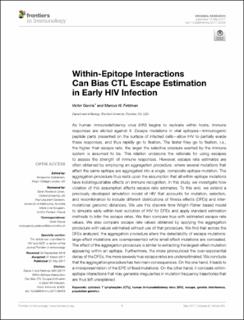Please use this identifier to cite or link to this item:
https://doi.org/10.21256/zhaw-3857| Publication type: | Article in scientific journal |
| Type of review: | Peer review (publication) |
| Title: | Within-epitope interactions can bias CTL escape estimation in early HIV infection |
| Authors: | Garcia, Victor Feldman, Marcus W. |
| DOI: | 10.21256/zhaw-3857 10.3389/fimmu.2017.00423 |
| Published in: | Frontiers in Immunology |
| Volume(Issue): | 8 |
| Issue: | 423 |
| Issue Date: | 1-May-2017 |
| Publisher / Ed. Institution: | Frontiers Research Foundation |
| ISSN: | 1664-3224 |
| Language: | English |
| Subjects: | Cytotoxic T lymphocytes (CTL); Escape; Genetic interference; Human immunodeficiency virus (HIV); Population genetics |
| Subject (DDC): | 571: Physiology and related subjects |
| Abstract: | As human immunodeficiency virus (HIV) begins to replicate within hosts, immune responses are elicited against it. Escape mutations in viral epitopes-immunogenic peptide parts presented on the surface of infected cells-allow HIV to partially evade these responses, and thus rapidly go to fixation. The faster they go to fixation, i.e., the higher their escape rate, the larger the selective pressure exerted by the immune system is assumed to be. This relation underpins the rationale for using escapes to assess the strength of immune responses. However, escape rate estimates are often obtained by employing an aggregation procedure, where several mutations that affect the same epitope are aggregated into a single, composite epitope mutation. The aggregation procedure thus rests upon the assumption that all within-epitope mutations have indistinguishable effects on immune recognition. In this study, we investigate how violation of this assumption affects escape rate estimates. To this end, we extend a previously developed simulation model of HIV that accounts for mutation, selection, and recombination to include different distributions of fitness effects (DFEs) and inter-mutational genomic distances. We use this discrete time Wright-Fisher based model to simulate early within-host evolution of HIV for DFEs and apply standard estimation methods to infer the escape rates. We then compare true with estimated escape rate values. We also compare escape rate values obtained by applying the aggregation procedure with values estimated without use of that procedure. We find that across the DFEs analyzed, the aggregation procedure alters the detectability of escape mutations: large-effect mutations are overrepresented while small-effect mutations are concealed. The effect of the aggregation procedure is similar to extracting the largest-effect mutation appearing within an epitope. Furthermore, the more pronounced the over-exponential decay of the DFEs, the more severely true escape rates are underestimated. We conclude that the aggregation procedure has two main consequences. On the one hand, it leads to a misrepresentation of the DFE of fixed mutations. On the other hand, it conceals within-epitope interactions that may generate irregularities in mutation frequency trajectories that are thus left unexplained. |
| URI: | https://digitalcollection.zhaw.ch/handle/11475/7946 |
| Fulltext version: | Published version |
| License (according to publishing contract): | CC BY 4.0: Attribution 4.0 International |
| Departement: | Life Sciences and Facility Management |
| Organisational Unit: | Institute of Computational Life Sciences (ICLS) |
| Appears in collections: | Publikationen Life Sciences und Facility Management |
Files in This Item:
| File | Description | Size | Format | |
|---|---|---|---|---|
| fimmu-08-00423.pdf | VicGarcia_FrontiersImmunology_Publication | 3.25 MB | Adobe PDF |  View/Open |
Show full item record
Garcia, V., & Feldman, M. W. (2017). Within-epitope interactions can bias CTL escape estimation in early HIV infection. Frontiers in Immunology, 8(423). https://doi.org/10.21256/zhaw-3857
Garcia, V. and Feldman, M.W. (2017) ‘Within-epitope interactions can bias CTL escape estimation in early HIV infection’, Frontiers in Immunology, 8(423). Available at: https://doi.org/10.21256/zhaw-3857.
V. Garcia and M. W. Feldman, “Within-epitope interactions can bias CTL escape estimation in early HIV infection,” Frontiers in Immunology, vol. 8, no. 423, May 2017, doi: 10.21256/zhaw-3857.
GARCIA, Victor und Marcus W. FELDMAN, 2017. Within-epitope interactions can bias CTL escape estimation in early HIV infection. Frontiers in Immunology. 1 Mai 2017. Bd. 8, Nr. 423. DOI 10.21256/zhaw-3857
Garcia, Victor, and Marcus W. Feldman. 2017. “Within-Epitope Interactions Can Bias CTL Escape Estimation in Early HIV Infection.” Frontiers in Immunology 8 (423). https://doi.org/10.21256/zhaw-3857.
Garcia, Victor, and Marcus W. Feldman. “Within-Epitope Interactions Can Bias CTL Escape Estimation in Early HIV Infection.” Frontiers in Immunology, vol. 8, no. 423, May 2017, https://doi.org/10.21256/zhaw-3857.
Items in DSpace are protected by copyright, with all rights reserved, unless otherwise indicated.